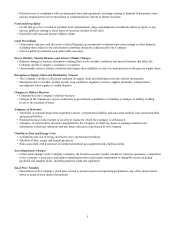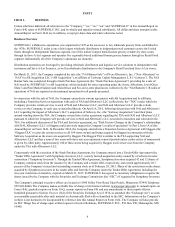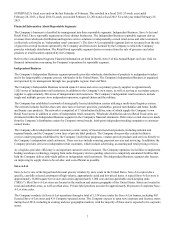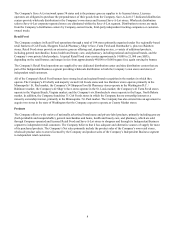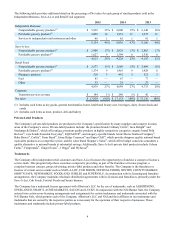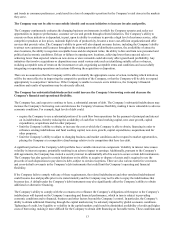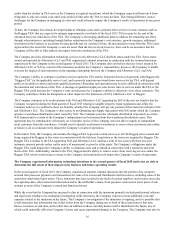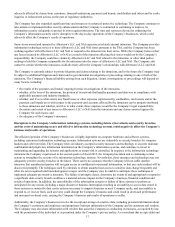Albertsons 2015 Annual Report Download - page 17
Download and view the complete annual report
Please find page 17 of the 2015 Albertsons annual report below. You can navigate through the pages in the report by either clicking on the pages listed below, or by using the keyword search tool below to find specific information within the annual report.15
increase or decrease in the Company’s required contributions to these multiemployer plans will depend upon many factors,
including the outcome of collective bargaining, actions taken by trustees who manage the plans, government regulations, the
actual return on assets held in the plans and the potential payment of a withdrawal liability if the Company chooses to exit a
market. Withdrawal liabilities could be material, and potential exposure to withdrawal liabilities may influence business
decisions and could cause the Company to forgo business opportunities. Increases in the costs of benefits under these plans,
coupled with both performance below the plans’ assumed rates of return in the equity and fixed income markets in past years
and withdrawals of other companies from these plans, have caused most multiemployer pension plans in which the Company
participates to be underfunded. Many of these plans have required rehabilitation plans or funding improvement plans, and the
Company can give no assurances of the extent to which a rehabilitation plan or a funding improvement plan will improve the
funded status of the plan. The Company expects that the unfunded liabilities of these plans will result in increased future
payments by the Company and the other participating employers over the next few years. Underfunded multiemployer pension
plans may, in certain situations, impose a surcharge requiring additional pension contributions. The Company’s risk of such
increased payments may be greater if any of the participating employers in these underfunded plans withdraws from the plan
due to insolvency and is not able to contribute an amount sufficient to fund the unfunded liabilities associated with its
participants in the plan. A significant increase to funding requirements could adversely affect the Company’s financial
condition, results of operations or cash flows.
The financial condition of these pension plans may also negatively impact the Company’s debt ratings, which may increase the
cost of borrowing, adversely affect the Company’s ability to access one or more financial markets or result in a default under
the Company’s debt instruments.
Changes in the Company’s relationships with NAI, Albertson’s LLC or Haggen could adversely impact the Company’s
results of operations.
In connection with the sale of NAI, the Company entered into the TSA with each of NAI and Albertson’s LLC to support the
divested NAI banners and the continuing operations of Albertson’s LLC. The TSA each had an initial term expiring on
September 21, 2015, subject to annual renewal by notice given at least 12 months prior to expiration of the then current term. In
September 2014, the terms of the TSA were renewed for an additional year and now end on September 21, 2016, unless
renewed again by notice given by NAI and/or Albertson’s LLC (or the Company with respect to the services it receives) no
later than September 21, 2015.
On April 16, 2015, following discussions with NAI and Albertson’s LLC regarding the impact of Albertson’s LLC’s acquisition
of Safeway, Inc. (the “Safeway Acquisition”) and their plans around winding down the TSA, the Company entered into a letter
agreement regarding the TSA with NAI and Albertson’s LLC (the “TSA Letter Agreement”) pursuant to which the Company
will provide services to NAI and Albertson’s LLC as needed to transition and wind down the TSA. The $50 million in
aggregate fees under the TSA Letter Agreement are separate from and incremental to the fixed and variable fees the Company
receives under the TSA. The Company estimates that the complete transition and wind down of the TSA could take
approximately four years. This estimate is based on the information currently known to the Company and could change
materially.
The transition and wind down of the TSA could be time consuming and resource intensive for the Company. The Company is
working with NAI and Albertson’s LLC to coordinate what will be required to fully transition and wind down the TSA and over
what timeline. This work will be on-going and could lead to disputes with NAI and Albertson’s LLC, including related to what
services the Company must perform to transition and wind down the TSA, the manner or timeline in which these transition and
wind down services are performed and the cost to perform these services which could cause disruptions and adversely impact
the Company’s results of operations.
The amount of revenue the Company receives under the TSA is based on the number of NAI and Albertson’s LLC stores and
distribution centers receiving services under the TSA. Pursuant to the terms of the TSA, and at any time during the transition
and wind down of the TSA, NAI and Albertson’s LLC may choose to not receive services at stores or distribution centers for
any reason. As stores and distributions centers are removed from the TSA, the variable fee the Company receives under the
TSA is reduced beginning ten weeks after the Company receives notice of such removal. The removal of stores or distribution
centers before September 21, 2015 would also reduce the fixed fee the Company receives under the TSA during the one-year
extension period (September 22, 2015 to September 21, 2016) and any future extension period(s). This reduction in the fixed
fee occurs every year for stores and distribution centers removed before September 21 of that year.
The impact of the TSA on the Company’s results of operations depends on the revenue being received by the Company and the
Company’s ability to manage its cost structure. The Company expects that the decline in TSA revenue from stores and
distributions centers no longer receiving services under the TSA as part of the transition and wind down of the TSA will happen


